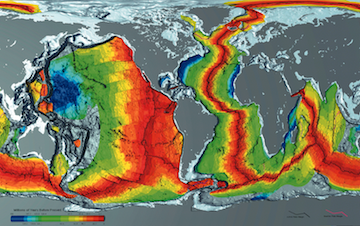ocean crust 1.png

Age of oceanic crust. Credit: National Oceanic and Atmospheric Administration
The crust at the bottom of the oceans is dense, heavy, and tough. Even so, it disappears in a hurry -- it’s pulled into the layer below the crust, where it melts and vanishes.
Ocean crust forms along mid-ocean ridges, where molten rock pushes up from the mantle, the layer below the crust. It’s denser than the rock that makes up the continents, and it has a different composition. As new crust forms, older crust is pushed off to the sides. It soon plunges below the continental crust and back into the mantle. So most ocean crust is no more than about 200 million years old, compared to up to four billion years for the oldest continental crust.
But, a recent study may have found the oldest bit of ocean crust yet seen. Researchers probed the bottom of the eastern Mediterranean Sea. The crust there is buried beneath several miles of sediments, so it’s hard to study. But instruments towed behind a ship measured the magnetic field in the crust. When the rock cooled, it maintained the alignment of Earth’s magnetic field at the time. So measuring that alignment acts as a sort of barcode, revealing the age of the crust.
Combined with satellite measurements of the region’s gravity, the barcode shows that the crust is about 340 million years old. If so, then it may have formed at the bottom of the Tethys Ocean, which existed when a single continent was breaking up to form the modern continents. That ocean no longer exists, but a small piece of its floor may remain -- at the bottom of the Mediterranean Sea.

